| WEBSITES
WORTH A PEEK! |
newenglandorchards.org
|
| SAVE THE DATE
NOVEMBER 19, 2010 |
Annual "NH Grazing Feast"
at
ZORVINO'S VINEYARD
Join us for an evening of live music, NH Wine & Cheese tasting,
locally grown, deliciously prepared harvest foods,
and a silent auction, to raise funds for our programs.
You will graze throughout the vineyard's beautiful dining facility, eating a variety of NH foods at each spot and getting a chance to meet the farmer who has grown or produced your evening's food.
Tickets may be purchased by calling our office at 603-224-1934.
To see more of the vineyard location, log onto
www.zorvino.com |

TALKING TURKEY...
|
A group of turkeys is called a "rafter."
A nest full of turkey eggs is called a "clutch."
The male turkey is called a "tom." The female is
called a "hen."
Only tom turkeys gobble. Hens make a clucking sound.
The red fleshy thing that hangs from a turkey's neck is called
a "snood."
Only Toms have the long tassel like hair hanging
from the lower neck. It is called his beard and is an easy way particularly in
wild turkeys to tell the boys from the girls.
Only Toms fan their tails
out, showing off.
Each Thanksgiving about
675 million pounds of turkey are consumed in the US. Americans
consume an average of 18 pounds of turkey meat per capita
each year.
Turkeys are raised extensively because
of the excellent quality of their meat and eggs.
Turkeys have 3,500 feathers at maturity.
Sesame Street's Big Bird costume is made of turkey feathers.
Turkeys were first domesticated by the Aztecs in Mexico.
Fossils show turkeys roamed Texas 2.5 million years ago.
Early European explorers took turkeys from the New World to
Europe in the 16th Century.
In Europe the species became established
as farmstead fowl.
In the 17th Century, English colonists brought
turkeys back to the New World, introducing European-bred types
to eastern North America.
When Europeans first encountered a turkey in the Americas,
they incorrectly identified them as a type of peacock, known
as a "turkey fowl" in Europe because it came from
the exotic East. At that time Europeans associated anything
from the east with the Ottoman Empire and often gave it the
name of Turkey, the seat of the Ottoman Empire.
They also assumed it was a turkey fowl because they thought
they were in Asia.
The US is the world's largest turkey producer and largest
exporter of turkey products. While exports are a major part
of the US turkey market, people in the US also eat more turkey
than people in other countries-13.6 pounds per person in 2007.
The top five turkey-producing states in 2007 were Minnesota,
North Carolina, Arkansas, Virginia and Mississippi.
While Americans prefer the white meat of
turkeys, most of the rest of the world prefers the dark meat.
Before modern transportation, farmers in the British Isles
put leather shoes on turkeys and walked them to market.
Turkeys are fed mainly a balanced diet of corn and soybean
meal mixed with a supplement of vitamins and minerals. On average
it takes 84 pounds of feed to raise a 30-pound tom turkey.
A hen usually grows 16 weeks and weighs 8-16 pounds when processed.
A tom takes about 19 weeks to get to a market weight of 24
pounds. Large toms (24-40 pounds) are a few weeks older.
Early in our history turkeys were kept on small farms not
just for their meat but also because they ate large numbers
of insects and so were a great source of pest control.
Turkeys are sometimes
difficult to raise because they are very curious and tend
to get their heads caught in fences. They must be taught
to eat from special feeders and waterers, just like other
baby animals.
Turkey skins are tanned and used to make items like cowboy
boots, belts and other accessories.
The ballroom dance known as the Turkey Trot was named for
the short, jerky steps a turkey makes.
|
IN THE NEXT ISSUE...
| Poinsettias and Christmas Trees
**************
Speaking of Poinsettias--
***********************
You are invited to attend an OPEN HOUSE at UNH!
The Gala Poinsettia Tree & Greenhouse
Open House
December 2-4
For more information,
contact
David Goodnow
at 862-2061
|
|
|
Howdy,
Welcome teachers and Agriculture in the Classroom friends to our
October newsletter. Can you see app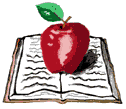 les
and not think of an apple for the teacher, A is for apple, or an apple a day...? Apple picking excursions have always been
traditional in our family, but this year is the first time I can remember
needing to call local orchards to find out if there is actually fruit to pick.
Late spring frosts caused heavy damages in various parts of New Hampshire, yet
many trees put out more buds anyway which produced apples way up higher, in
some cases too high for u-pick operations to risk letting the public pick. Nevertheless, there
are plenty of orchards open for fall fun and frolic that results in fragrant kitchens
and healthy treats. We invite you to
call or write us for materials to sweeten up your autumn days by integrating
apple facts and stories into your math, science, history and literature
lessons. les
and not think of an apple for the teacher, A is for apple, or an apple a day...? Apple picking excursions have always been
traditional in our family, but this year is the first time I can remember
needing to call local orchards to find out if there is actually fruit to pick.
Late spring frosts caused heavy damages in various parts of New Hampshire, yet
many trees put out more buds anyway which produced apples way up higher, in
some cases too high for u-pick operations to risk letting the public pick. Nevertheless, there
are plenty of orchards open for fall fun and frolic that results in fragrant kitchens
and healthy treats. We invite you to
call or write us for materials to sweeten up your autumn days by integrating
apple facts and stories into your math, science, history and literature
lessons.
An old Yankee
farmer taught me an ages old symbiotic practice that supposedly ensured better
health for apples, sheep and humans.
Orchard keepers used to spray a pesticide on the trees to fight various
bugs, and shepherds dosed their sheep with another form of the same substance
to battle internal parasites. Some Yankees found that by pasturing sheep in the
orchards to clean up the drops, the sheep and the trees were both healthier
without having to dose the sheep. Since
we began on our present farm 4 years ago, the sheep have helped us clear the
land and we have discovered ancient apple trees along with blueberry bushes. We
do not use that pesticide, but each year my apples have increased in size and
quality as my sheep have thrived on the fruit from the June drops until late in
the year. And our stewardship job is
mainly protecting the trees from being chewed. What an amazing world in which
we live.
As we continue to
create a new and stronger face on our granite state program of Ag in the
Classroom, I would like to share some of my goals. I hope to build a network of
partners throughout our state in all areas that are involved with gaining a
better understanding of how we all work together to have a healthy place and
happy lives. For starters I am looking for a liaison person in every elementary
school and every home school group. I
hope to gain an AITC coordinator in every county like Deb Robie in Grafton
County (She is paid through the Grafton County Farm Bureau, but there could be
other ways of doing that). I believe we can hold at least one School to Farm
event in every county. We have had 4 in 2010 so far - that is almost half
already! Please contact us about becoming a partner and
/or organizing a School to Farm day.
The office is being
covered with temporary help until we hire a new State Coordinator. We have over
20 applications, and will be accepting more for a few days after you receive
this.
Please join us at
our fundraising event at Zorvino's on November 19th and/ or contribute
something for our silent auction.
This month we are
grateful to our board member Kris Mossey for our feature article. We are here to
help you add some beneficial zest into your teaching, so think of us as you
chomp into that next fresh tangy apple.
Jozi Best, President
P.S. Did you know...Mac is my apple. I eat an apple every day and I
pine when I cannot get a mac. It used to
be the greatest hardship of living and working seasons in the midwest where
there were months without seeing a mac.
|
APPLE PICKING TIME!
|
|  October is the time of the year when many people in NH visit
their local apple orchard to pick their own apples. At our family's apple orchard we are very
busy this time of the year. We are vendors at a local farmers market, sell
apples, pumpkins and squash at our farm stand and open our orchard to the
public for pick your own apples. In late September and October schools in our
area bring students on field trips to our orchard to pick apples and learn
about farming in New Hampshire. Many apple growers in New Hampshire host school
groups during the apple picking season. This creates an important connection
between farms and schools in our state. October is the time of the year when many people in NH visit
their local apple orchard to pick their own apples. At our family's apple orchard we are very
busy this time of the year. We are vendors at a local farmers market, sell
apples, pumpkins and squash at our farm stand and open our orchard to the
public for pick your own apples. In late September and October schools in our
area bring students on field trips to our orchard to pick apples and learn
about farming in New Hampshire. Many apple growers in New Hampshire host school
groups during the apple picking season. This creates an important connection
between farms and schools in our state.
At a recent field trip, a teacher at one of our area schools
told me that what she and the children liked best about visiting our orchard
was hearing the story about our family's farm. I always greet the children by
telling them about how my grandfather and his brother decided to be apple
growers in the 1940's. They purchased our apple orchard in Milford where we
still care for and pick apples from those same trees. We take a walk to another
orchard on our property that my father planted when I was in high school and
some newly planted trees that are beginning to bear fruit.
Children ask quite a lot of questions about apples. They also tell me about what their favorite
variety of apple is. I always hope they say "McIntosh". Many of the children already know that the
correct way to pick an apple is to just give it a little twist! The school
groups that visit our farm have a great time in the orchard. It is an
experience that they will remember. The children of today will be the consumers
of tomorrow.
I hope that you, your family and your school will take the
time to go apple picking at your local farm this October.

Kris Mossey
Apple Grower
McLeod Bros. Orchards
Milford, NH
|
THE BOOKSHELF
|
| 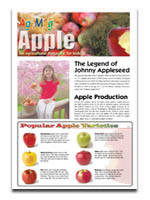 Apple Ag Mag Apple Ag Mag
The Apple Ag Mag is a 4 page multidisciplinary magazine for grades 3-5. It
contains information about apple production, history, growth, myth, and
varieties. The Ag Mag also includes classroom activities such as make an Apple
Life Cycle Chain, and experiments such as Sugar vs. Starch. On the back page it
explores apple related careers. Order here.
Harvest
Year by Cris Peterson (Best
for ages 5-9)Cris Peterson
captures the concept that every single month food is being harvested somewhere
in the United States
with colorful and dramatic photos by Alvin Upitis. This book 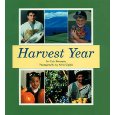 is a collaboration of clear and concise
text and a map of harvest locations across the country. With an array of photographs that
capture the colorful fields and orchards and a variety of workers and machines and children sampling
foods from the year's harvest. While not every state is included, 27 states representing every
region of the country are included, from Maine to Hawaii and Alaska to Florida.
Harvest
Time by Jerry Cipriano
(Best
for ages 4-7)
This is an early
reader book with short statement sentences in a large font. While the content
is minimal this would be
a very good book for a teacher to use to begin to teach reading for content. The content
and pictures could be used to begin to teach about the life cycle and seasons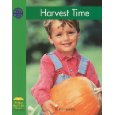
in science. What is
particularly nice about this book is that the photographs and text depict how the fruit, vegetables
or grain are grown, show the plant as it is either growing or ripe, describe and the harvest
process. The photographs enhance the text and depict modern agriculture
including apples being picked from dwarf trees.
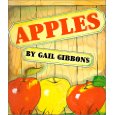
Apples by Gail Gibbons
(Best for ages 5-8)
From blossom to
pollination to picking, this beautifully illustrated book details how apples
grow, their various parts,
and the different varieties. This book also includes instructions on how to plant and care for an
apple tree.
Apples
Here! by Will Hubbell (Best for ages 5-8)From blossom to
pollination to picking, this beautifully illustrated book details how apples
grow, their various parts,
and some of the different varieties. The rhyming text takes the reader on a year-long journey
from winter with a young  girl and her grandfather to spring with a boy and girl to summer where three
children enjoy the orchard and watch apples develop through fall where two boys enjoy the
harvest and fresh-from-the-tree apples. Another girl buys apples at a farm market and uses them
to make a pie and others include apples in celebrations. The final page is of a deer also
enjoying the apples. The book also includes a detailed description of the apple production process, varieties, history
and uses.
Hooray
for Orchards! by Bobbie Kalman
(Best for ages 7-12)
This book provides a
nice overview of orchards and fruit production of many types. It begins with a description of
various types of fruit and which of those fruits are produced in orchards. Images depict modern
dwarf varieties of apples, grafting, flowering and pollination, pruning, spraying. Harvesting
and processing. The book concludes with a
short glossary and
recipe for apple crisp. This book is a well written and illustrated source of information.
How Do
Apples Grow by Betsy Maestro (Best for ages 5-10)This well-illustrated
book detailing apple production can be  used in a unit teaching about seasons, pollination,
parts of the flower, honey production or just apples. It does an excellent job depicting the total
process from dormancy through apple harvest. A credible illustration of apple harvest depicts dwarf
apple trees which are the modern image of an orchard and seen in very few books of this type.
Turkeys
on the Farm by
Mari C. Schuh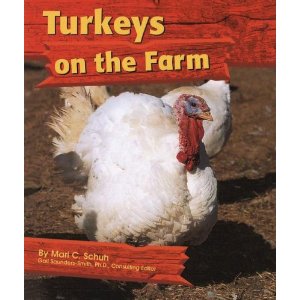
(Best for Ages 4-7)
This book introduces
the reader to turkeys on the farm. It shows the different parts of the turkey as well as the
difference between a tom and a hen. The book explains that turkeys are raised
for their meat and shows
how farmers feed and take care of the turkeys. |
TEACHERS...Did you know about this?
|
| Applications for the 2011 White-Reinhardt mini-grants and teacher scholarships are available at the Ag Foundation's website. You can review the 2010 winners under the "What We Support" section.
The Mini-Grant Program funds projects that will increase agricultural literacy. County and state Farm Bureaus may apply for grants of up to $500 for classroom education programs for grades K-12 to initiate new programs or expand existing programs to additional grade levels or new subject areas. Grants are available on a competitive basis.
The National Agriculture in the Classroom Conference Educator Scholarship program is to provide travel expense funds to educators employed by a school system to attend the national conference (read about the national conference here) and then use the information gained to expand their outreach to students regarding food, fiber and fuel. Educators employed by a school system and working in grades k-12 who have demonstrated involvement in agricultural literacy programs are eligible to apply.
Specific guidelines and deadlines for the application process can be found on each application, but all applications must be signed by a state Farm Bureau contact and postmarked to the Foundation by November 1, 2010.
The White-Reinhardt Fund for Education is a special project of the Ag Foundation in cooperation with the AFB Women's Leadership Committee. It was established to honor two former chairs of that committee, Berta White and Linda Reinhardt, who were leaders in the national effort to improve agricultural literacy. |
|
|